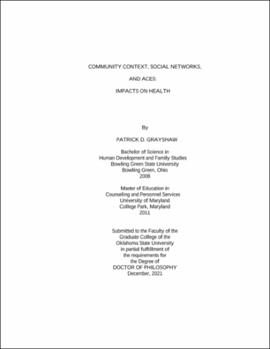| dc.contributor.advisor | Stout, Mike | |
| dc.contributor.author | Grayshaw, Patrick D. | |
| dc.date.accessioned | 2023-08-21T19:42:36Z | |
| dc.date.available | 2023-08-21T19:42:36Z | |
| dc.date.issued | 2021-12 | |
| dc.identifier.uri | https://hdl.handle.net/11244/338888 | |
| dc.description.abstract | A health crisis has emerged in the United States lowering life expectancy between 2014 and 2017. Specifically, health disparities are a current issue, varying by geography and social inequalities. Since 1998, ten adverse childhood experiences (ACEs) have been identified as having a graded relationship with negative adult health outcomes. The present research seeks to understand the predictors of ACEs that can be addressed to mitigate experiencing an ACE. Furthermore, the present research seeks to understand the role those individual social connections play as a protective factor for negative health outcomes when someone has experienced ACEs. | |
| dc.description.abstract | Results from the first study indicated that community factors were associated with ACEs, as conceptualized through household dysfunction and adverse family experiences, in a national sample of children. Using data from the National Survey of Children’s Health, it was found that higher SES, engagement, neighborhood and school safety, and school attendance were associated with lower household dysfunction. Similarly, higher SES, neighborhood and school safety, and school attendance were associated with adverse family experiences. However, differences existed between household dysfunction and adverse family experiences. Neighborhood amenities were not related to household dysfunction while it was positively related to adverse family experiences. Additionally, having an adult mentor was positively related to household dysfunction while having no significant relationship with adverse family experiences. | |
| dc.description.abstract | The second study used data from the UCNets Social Network study. Through this study, it was discovered that select characteristics of social networks served as moderators for various health outcomes. Homophily, or friends with similar personal characteristics to self, served as a protective factor for health outcomes when experiencing household dysfunction. In contrast, emotional closeness, frequency of contact with friends, and social network instability were associated with worse health outcomes. | |
| dc.description.abstract | Findings from the present research support the work of developing self-healing communities that can focus on improving community environments to mitigate the risk of experiencing adverse childhood experiences. It also supports developing strong social networks of people to support one another, potentially bringing those who have experienced ACEs together. Finally, the results support looking into the way we measure ACEs and understanding the difference between groups of ACEs. | |
| dc.format | application/pdf | |
| dc.language | en_US | |
| dc.rights | Copyright is held by the author who has granted the Oklahoma State University Library the non-exclusive right to share this material in its institutional repository. Contact Digital Library Services at lib-dls@okstate.edu or 405-744-9161 for the permission policy on the use, reproduction or distribution of this material. | |
| dc.title | Community context, social networks, and ACEs: Impacts on health | |
| dc.contributor.committeeMember | Washburn, Isaac | |
| dc.contributor.committeeMember | Beasley, Lana | |
| dc.contributor.committeeMember | Moore, Tami | |
| osu.filename | Grayshaw_okstate_0664D_17418.pdf | |
| osu.accesstype | Open Access | |
| dc.type.genre | Dissertation | |
| dc.type.material | Text | |
| dc.subject.keywords | ACEs | |
| dc.subject.keywords | community | |
| dc.subject.keywords | health | |
| dc.subject.keywords | NSCH | |
| dc.subject.keywords | social network | |
| dc.subject.keywords | trauma | |
| thesis.degree.discipline | Human Sciences | |
| thesis.degree.grantor | Oklahoma State University | |
